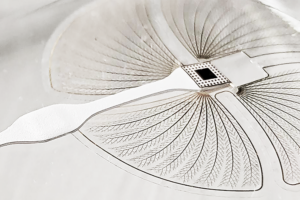-
Synaptive Medical, Panaxium team up to improve brain mapping
Oct. 14, 2o22
Originally Published: BioWorld MedTech
By: Meg Bryant
Synaptive Medical Inc., and Panaxium SAS have inked a deal to bring high-resolution, real-time, artificial intelligence (AI)-assisted cortical mapping to neurosurgeons. Under the collaboration, Synaptive’s Modus V robotic exoscope technology will be integrated with Panaxium’s ultra-flexible iontronic electrocorticography (ECoG) platform.
The combination will provide surgeons with unequaled real-time insights to map critical details of bioelectrical connections in the brain during surgery, the companies said.
Strategic partnership
Combining iontronic surfaces and AI-assisted software in real-time during neurosurgery has never been done before, Brad Schmidt, Panaxium’s founder and CEO, told BioWorld. “This is an enormously important research partnership, for Panaxium and for the field.”
Cameron Piron, co-founder and CEO of Toronto-based Synaptive, called the collaboration “the first stepping stone toward the more effective use of [brain] devices in conjunction with imaging, both preoperative and real-time operative as well.”
Modus V is a robotically controlled digital microscope intended for use in minimally invasive cranial and spine procedures. Its latest iteration, released in January 2020, includes 3D visualization and voice-activated control.
Panaxium’s iontronic ECoG platform uses an ultra-elastic membrane designed to conform to the cortex of the brain, and a series of recording and stimulating “electrodes,” actually ion-conducting and semi-conducting polymers. The specific nature of these components makes them especially sensitive for recording brain signals, as well as for stimulating neural activity with very high precision. The neural data that is collected is parsed using AI to provide clinicians with real-time, actionable information in the operating room.
Currently, surgical technologies tend to focus either on preoperative imaging and planning or on real-time detectability during the procedure. Synaptive and Panaxium aim to. Bring both worlds together in the operating suite, Piron said.
“Panaxium’s iontronic (vs. traditional electronic) approach is an outstanding interface for mapping the cortex, and on its own already provides many improvements desired by neurologists and functional neurosurgeons,” Schmidt said. “But the combination of Panaxium’s highly precise and sensitive electrocorticography data is orders of magnitude more insightful and actionable when combined with all of the other information that Synaptive collects and presents to clinicians in the neurological OR.”
Upcoming pilot study
The benefits of the co-development collaboration will be evaluated in a pilot trial at hospitals in Paris, sponsored by the Institut national de la santé et de la recherche médicale (INSERM).
Expected to get underway next year, the study will assess the surgical effectiveness of the combined technologies, both the ability to preserve brain function during surgery and to better define targets for surgical resection, Piron told BioWorld.
“This first implementation will allow us to really optimize the two technologies” and be able to “really show the benefit of bringing this extremely high-resolution cortical mapping tool and then linking it with our intraoperative technology,” he said.
Panaxium, which has its headquarters in Aix-en-Provence, France, is in the process of applying for regulatory clearance for research purposes. Schmidt said he expects Synaptive will seek U.S. clearance for a product using its technology as well.
The pilot study will lay the groundwork for a broader multicenter trial, the companies said.
“The ability to build up pathological biomarker maps with microresolution electrocorticography over large areas of the cortex is a huge step forward for clinical research,” said Gilles Huberfeld, a neurologist at the Hôpital Fondation Adolphe de Rothschild and INSERM, who will lead the study. “The alignment of ultra-precise electrophysiological information with a patient’s surgical planning information in real-time makes the Synaptive-Panaxium solution the ultimate neuro-navigation tool for brain surgery.”
Large addressable market
Both companies see future opportunities for the co-development agreement.
“There is incredible potential for this type of interface for other monitoring tools, as well as neuromodulation therapies. At Panaxium, we are developing a precision neuromodulation therapy for adding recovery after stroke, a hugely undertreated indication that we believe will benefit greatly from the enabling advantages of an iontronic approach to neuromodulation,” Schmidt said.
Piron said the combo could improve clinicians’ ability to affect a range of degenerative diseases. Noting the proliferation in recent years of medical devices in the brain, “where we see a really big miss is the ability to provide better imaging in the context of this [iontronic ECoG] device.”
The initial application of the partnership will involve physiological brain mapping for oncological surgeries in the brain.
“This first step is a very precise application, but hopefully it will build a bridge to be able to do many more exciting things,” Piron said.

BACK TO NEWS ARTICLES